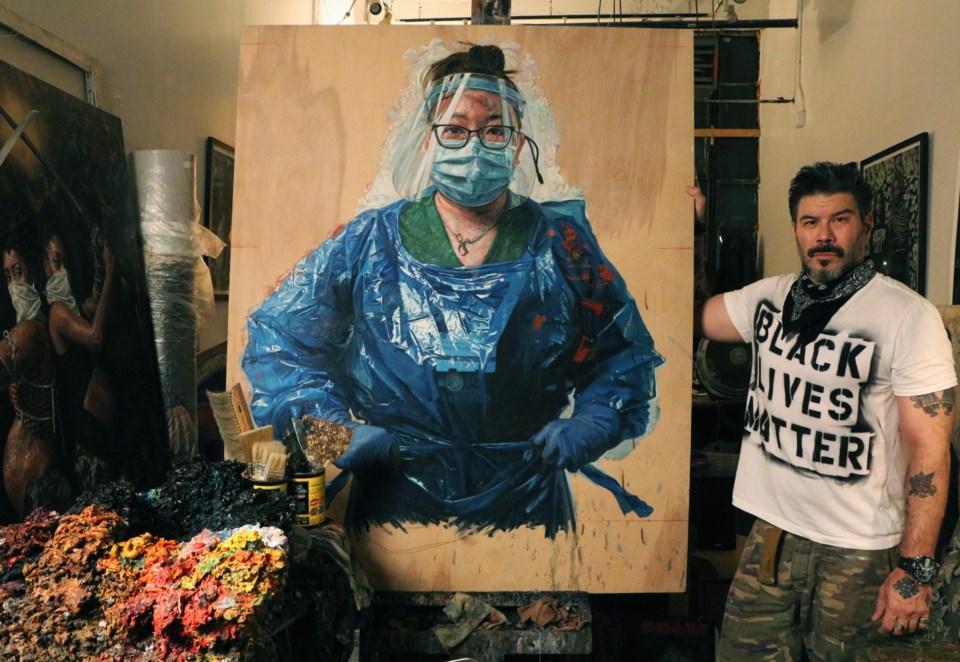As a ten-year-old boy, Tim Okamura's parents enrolled him in a painting class where he began what would become a life-long journey of bringing stories to life on canvas. When he first picked up a paintbrush, Okamura knew that he had a knack for portraiture — telling the stories of other humans.
Now, the 53-year-old Bushwick painter has channeled that knack into a series of paintings he calls "Healthcare Heroes." The series features nurses who have worked tirelessly during the pandemic.
In March 2020, Okamura found out his cousin passed away from COVID-19 on the same day he discovered he had the virus.
"I was still processing the loss of my cousin and I was quite ill myself. I was looking out my window and seeing bodies being wheeled into refrigerator trucks," Okamura said. "Not one, not two, but three trucks."
Wyckoff Heights Medical Center, which he lives across the street from, had become overwhelmed with COVID-19 patients and the morgue was at capacity.
One day, Okamura saw a "Today" show interview featuring travelling nurses who had come to New York in the height of the pandemic. One nurse inspired him enough to create a painting called "Travelling Nurses."
Later, an Instagram follower discovered Okamura's work and put him in touch with nurses from NYU Langone in Brooklyn. These nurses later became the subjects in two paintings, titled "PPE" and "Nurse Tracey."
The latter is what Okamura referred to as "Rosie the Riveter Part Two," representing the strength and courage that nurses have maintained during the pandemic.
In highlighting strength, Okamura knew he also needed to show the moments of anguish. In a painting titled, "Nurse Patti," a nurse is looking "heavenward," which Okamura believes "captured the moment in between despair and prayer."
He was later able to talk to two nurses from Wyckoff Heights Medical Center. Okamura asked them what the toughest part of working during the pandemic was. While they discussed pediatric cases, the nurses began to cry.
This image became Okamura's "Grief," which is the first time he'd ever painted someone crying.
"I think a lot of nurses were compartmentalizing their feelings to stay professional," Okamura said. "But it was important for me to show that side of things."
As a Japanese and Canadian artist, Okamura began painting portraiture when he was a child by using his diverse circle of friends as subjects. Depicting his companions — who were from Trinidad, Jamaica and Guyana — was the beginning of a "path of representation" for Okamura.
His journey to create art that adds "imagery to the canon of traditional academic portraiture" has continued into his portraits of nurses. Okamura believes these paintings will serve as a reminder of an extremely important historical period in Brooklyn and beyond.
In completing these paintings, however, Okamura had a much larger realization.
"These nurses and workers were always there for us," Okamura said. "It took the pandemic to shine a spotlight on their efforts. It wasn't just for this period of time — it's been that way for their whole career."
With this realization came Okamura's need to express gratitude to these nurses. He does this through his art.
While he didn't begin this series for personal benefit, the experience has been rewarding. Beyond the heartfelt messages from frontline healthcare workers, Okamura has had numerous opportunities to showcase his work.
The New York Historical Society has added his "Nurse Tracey" painting to their permanent collection. This is the collection's first portrait and second painting by an artist of Asian descent.
Okamura's biggest goal is to give back to the nurses whose stories he has depicted.
"Whether or not they want to be called heroes, I do regard them in a heroic way," Okamura said. "I don't think I could ever really do enough to do them justice, but I'm trying my best."



.png;w=120;h=80;mode=crop)
